Calorie display requirements
Where must calories be displayed?
Calories must be displayed on any menu that lists or depicts standard food items offered for sale by a regulated food service premises. A menu includes:
- Paper Menus
- Electronic Menus (e.g. menus on tablets)
- Menu Boards
- Drive-Through Menus
- Online Menus
footnote 1 - Online Menu Applications
footnote 1 - Advertisements, except for billboards, radio and television advertisements
footnote 1 - Promotional Flyers
footnote 1
Where standard food items are put on display, calories must be displayed on labels or tags.
Catering menus are exempt from the requirements of the HMCA.
An owner/operator can determine whether or not the HMCA applies to a menu by answering ‘yes’ or ‘no’ to the questions in the diagram that follows:

Example #3: Displaying calories on a restaurant menu

Example #4: Displaying calories on a take-out menu
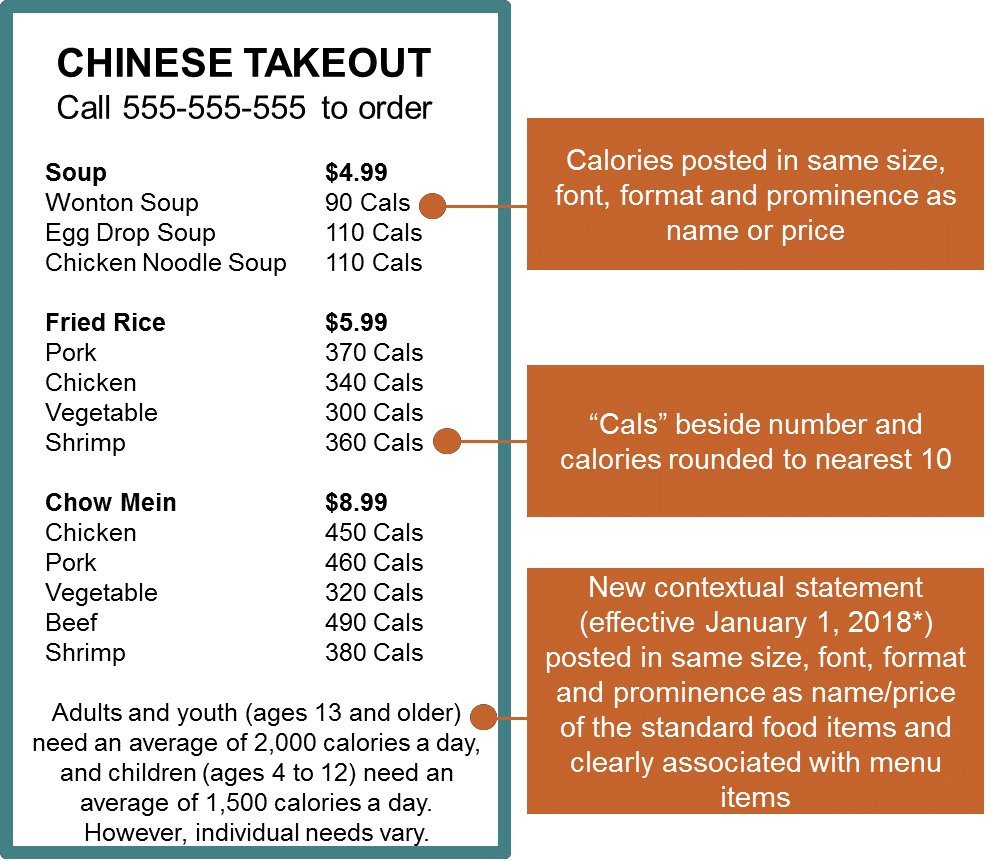
Example #5: Displaying calories on an online menu

How must the calorie information be displayed?
Calories for standard food items must be displayed:
- Adjacent to the name or price of the standard food item;
- Unobstructed and readily legible to customers; and
- In the same font and format as, and at least the same size and prominence as, the name or price of the standard food item.
If an owner or operator should choose to post calories based on the font size of the price, and the fonts in the price vary in size (i.e. different sized fonts are used for the dollar value and cents value), then calories must be in at least the same size as the largest font size in the price.
In order to distinguish the calorie information from other numbers on the menu or display tag, the term ‘‘Calories’’, “CALORIES” ‘‘Cals” or “CALS’’ must appear:
- Adjacent to the number of calories for each standard menu item; or
- As a heading above a column listing the number of calories for each standard menu item.
The term “Calories”, “CALORIES”, “Cals” or “CALS” must be displayed in the same size, font and prominence as the calorie number.
How must the calories be rounded?
To simplify the calorie information displayed on menus and display tags, and acknowledging that prepared food has some inherent variability, calorie information must be rounded using standard rounding rules to the nearest:
- 10 for items with over 50 calories;
- 5 for items with over 5 to 50 calories;
- whole number for items with half a calorie to 5 calories; and
- 0 for items with less than half a calorie.
How must calories be displayed for items intended for more than one person?
These requirements are only intended for multi-person items and do not apply to meals intended for one person.
The following information must be displayed for standard food items normally intended for more than one person (i.e. multi-person items):
- The calories for the entire item and the number of servings the item is comprised of; or
- The calories for a serving size of the item and the number of servings the entire item is comprised of.
Example #6: Displaying calories for multi-person item using calories for the entire item
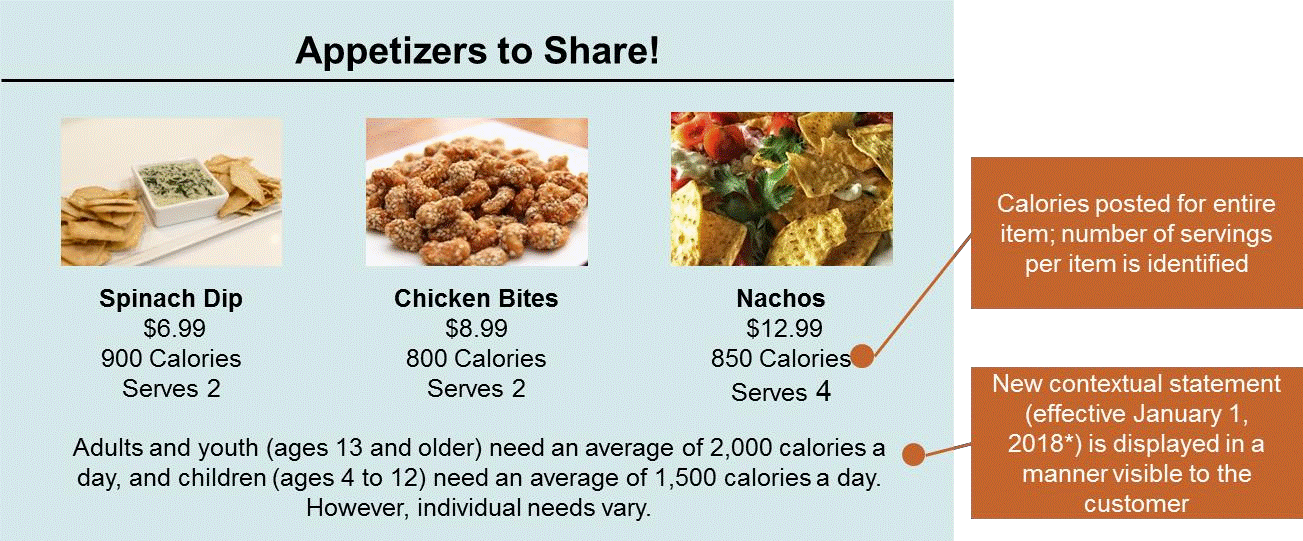
Example #7: Displaying calories for a multi-person item using calories for a serving size
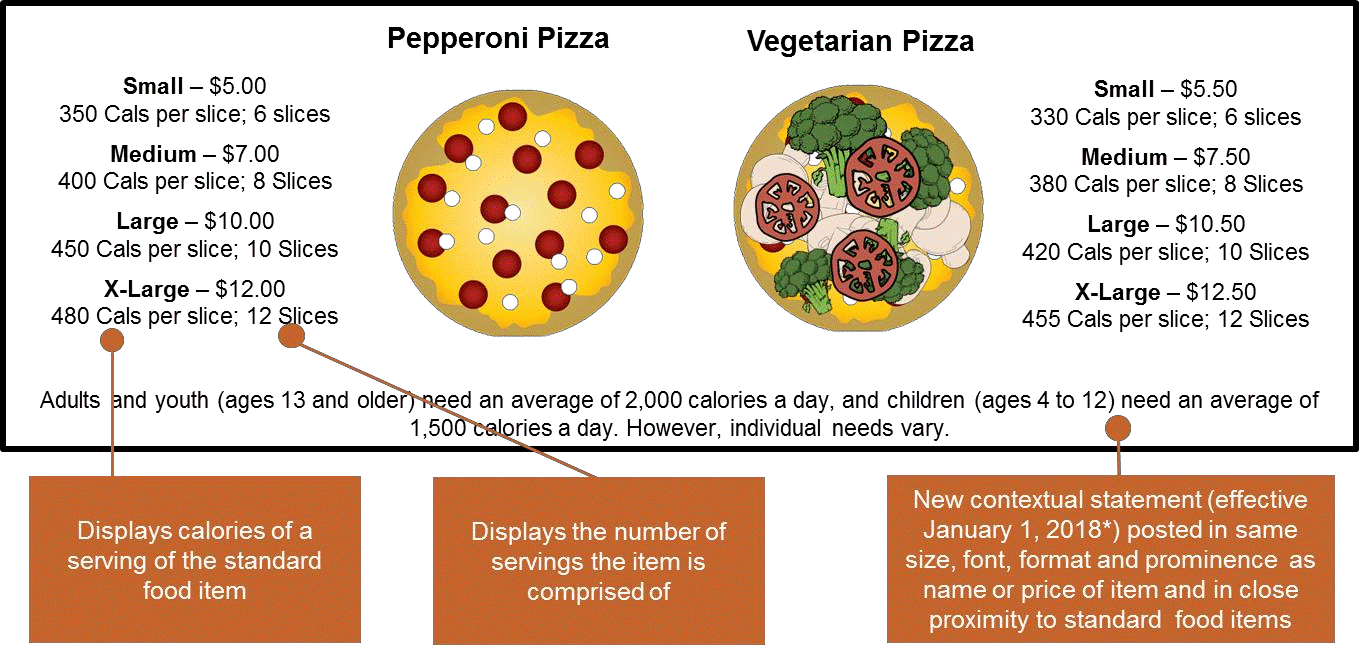
How must calorie information be displayed for menu items with multiple flavours, varieties or sizes?
For menu items that are offered in different flavours, varieties, or sizes:
- If the menu, label or tag only includes a general description of the standard food item and does not list the flavours, varieties or sizes, the calorie range for the available flavours, varieties or sizes must be listed;
- If the menu, label or tag lists specific, flavours, varieties or sizes of the standard food item, the number of calories for each flavour, variety or size must be listed, and
- If the menu, label or tag does not list the available flavours or varieties of the standard food item, and the item is on display in a way that the serving size cannot be assessed ( e.g.tub of ice cream) owners or operators must post a sign with the following information:
- name of the item,
- number of calories for a serving of each flavour/variety, and
- serving size.
- The information must be posted on a sign that meets the signage requirements ofs. 8 of the regulation. For example, the sign must:
- be in close proximity to and clearly associated with the item; and
- include the term "Calories" or "Cals" written in the same size, font and prominence as the calorie numbers, and either adjacent to the number of calories or as a heading above a column listing the calories.
A sign does not have to be posted if the information that is required to be posted on the sign is set out clearly on a label or tag associated with each food or drink item that complies with the requirements in subsection 6(1) of the Regulation.
Example #8: Displaying calories for items with multiple flavours when a general description is provided on the menu

Example #9: Displaying calories for menu items with multiple varieties at a quick service café

Example #10: Displaying calories for standard food items on display in bulk form

How must calories be displayed for menu items intended to be personalized?
For items assembled based on customer preferences (i.e. variable or customizable items) calories must be displayed for:
- The basic preparation of the item (i.e. default);
- Each available supplementary item (e.g.dressings, sauces, toppings, flavourings); and
- Each available supplementary item for each size of the standard food item it complements (this may also be displayed as a range).
A statement must also be included that indicates that the calories of supplementary items are additional to the calories displayed for the basic preparation of the standard food item. Alternatively, a “+” (plus) sign plus the number of calories for the supplementary item could be used to signify an increase in calories (e.g. ‘Add cheese sauce for $1.99! +100 Cals’).
Example #11: Displaying calories at a sandwich shop with personalized toppings
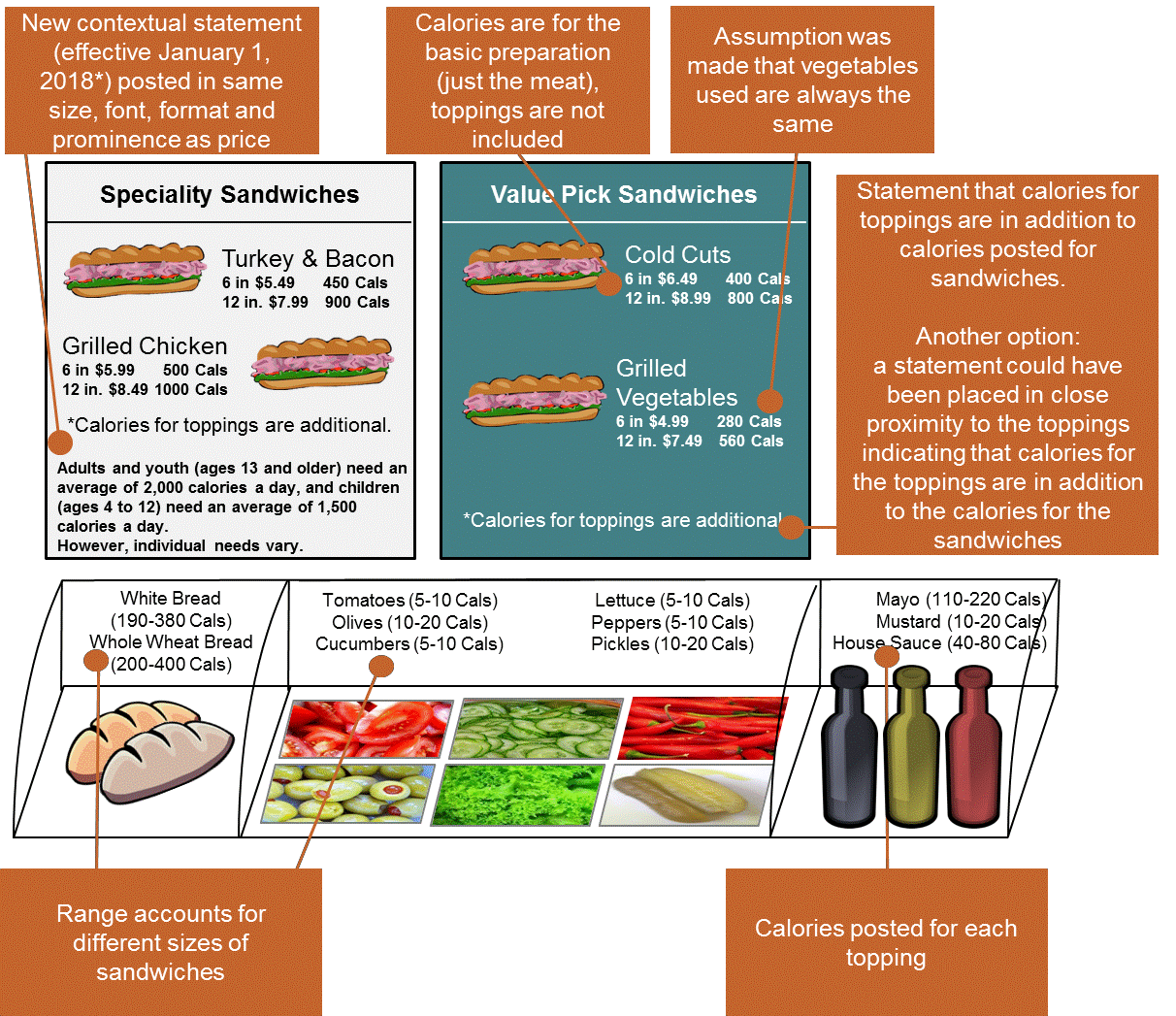
Example #12: Displaying calories for sandwiches with standardized customization options

Example #13: Displaying calories for pizzas with standardized customization options
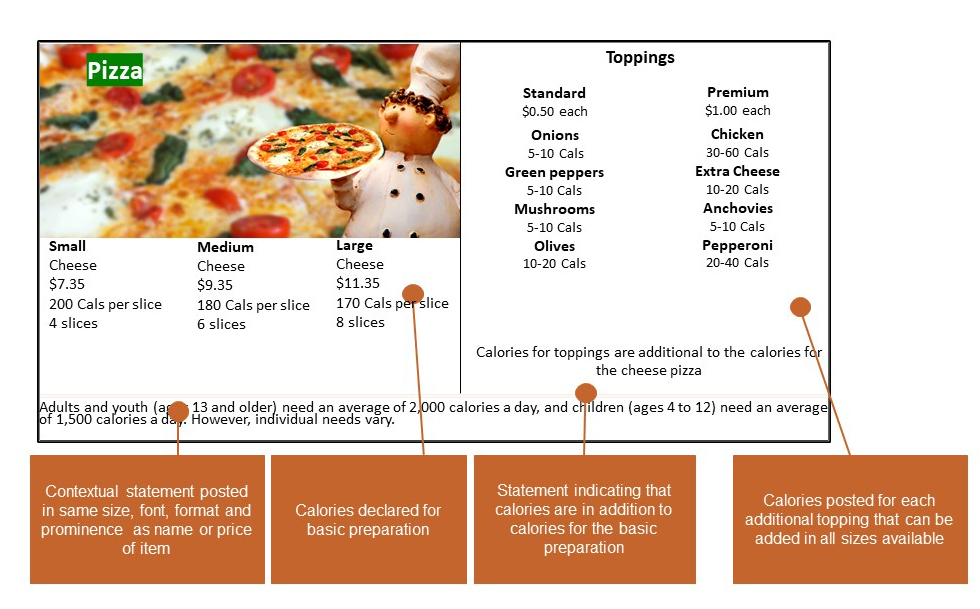
How must calories be displayed for combination meals?
Combination meals should be treated as one standard food item, and calories must be posted for the entire combination meal.
- Where a menu has two or more choices for menu items in a combination meal (e.g. a sandwich with fries, a side salad, or fruit), calories for the combination must be declared as a range (e.g. 450-700 calories).
- If the variable items that can be part of a combination meal are individually listed on the menu, label or tag, then the number of calories for each possible option must be displayed.
- If the variable items that can be a part of the combination meal are on display for the customer to choose the item, but they are on display in bulk in a way that the serving size is not evident (e.g.tray of noodles on display), owners or operators must post a sign with the following information:
- name of the item,
- number of calories for a serving of each flavour/variety, and
- serving size.
- The information must be posted on a sign that meets the signage requirements of s. 8 of the regulation. For example, the sign must:
- be in close proximity to and clearly associated with the item and
- include the term "Calories" or "Cals" written in the same size, font and prominence as the calorie numbers, and adjacent to the number of calories or as a heading above a column listing the calories.
- A sign does not have to be posted if the information that is required to be posted on the sign is set out clearly on a label or tag associated with each food or drink item that complies with the requirements in subsection 6(1) of the Regulation.
- Where combination meals are sold with the option of changing the size of an item (e.g. super-sizing a side) the impact that the change in size has on the caloric content of the meal must be displayed. The calorie difference must be declared for the increased or decreased size (e.g., "Adds 100–250 calories," "Subtracts 100 calories").
Combination meals intended for more than one person must post the calorie range as per the requirements of multi-person items and combinations meals (e.g. 2000- 3000 Cals; 4 servings or 500-750 Cals per serving; 4 servings).
Example #13: Displaying calories for basic combination meals
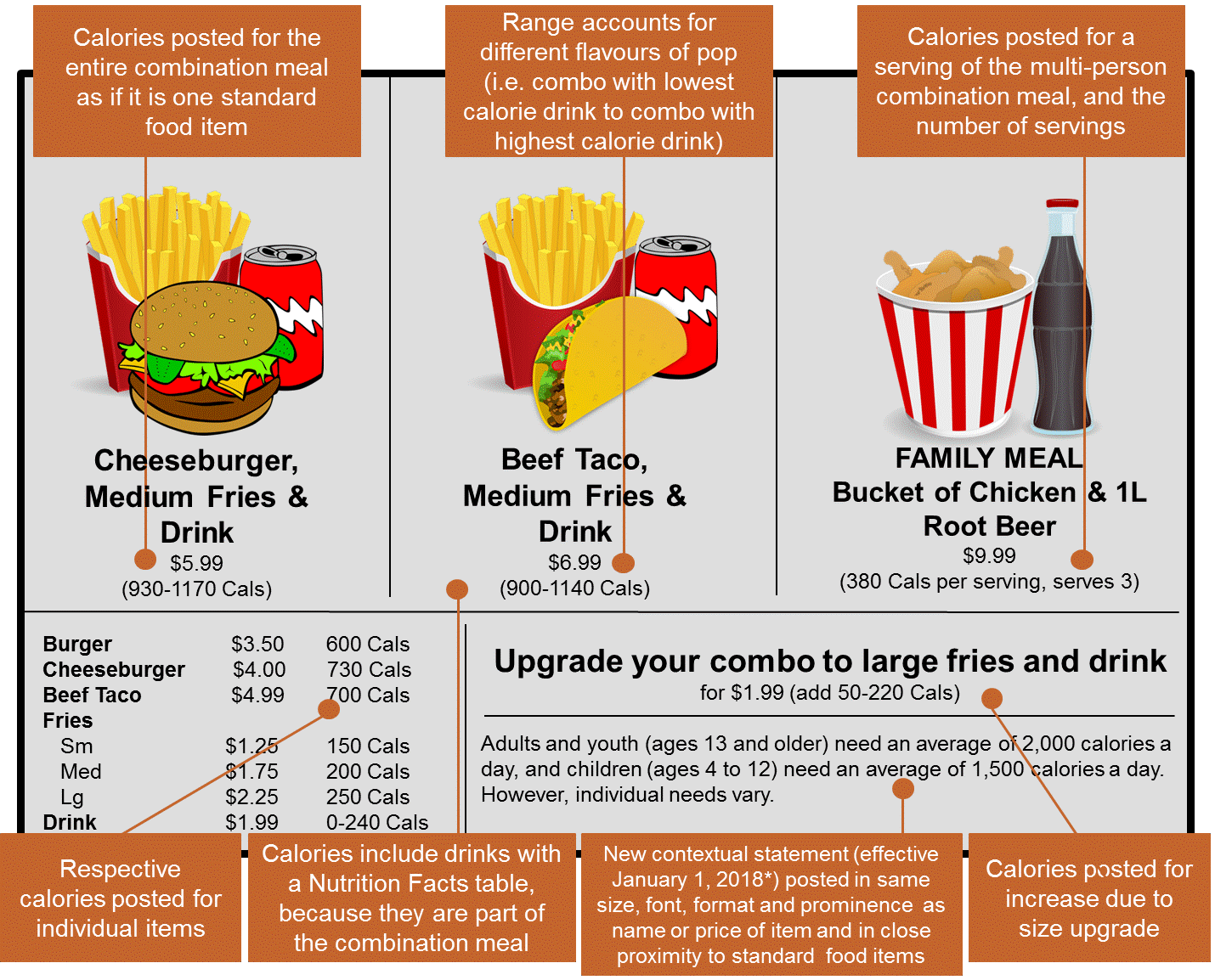
Example #14: Displaying calories for multi-person combination meals
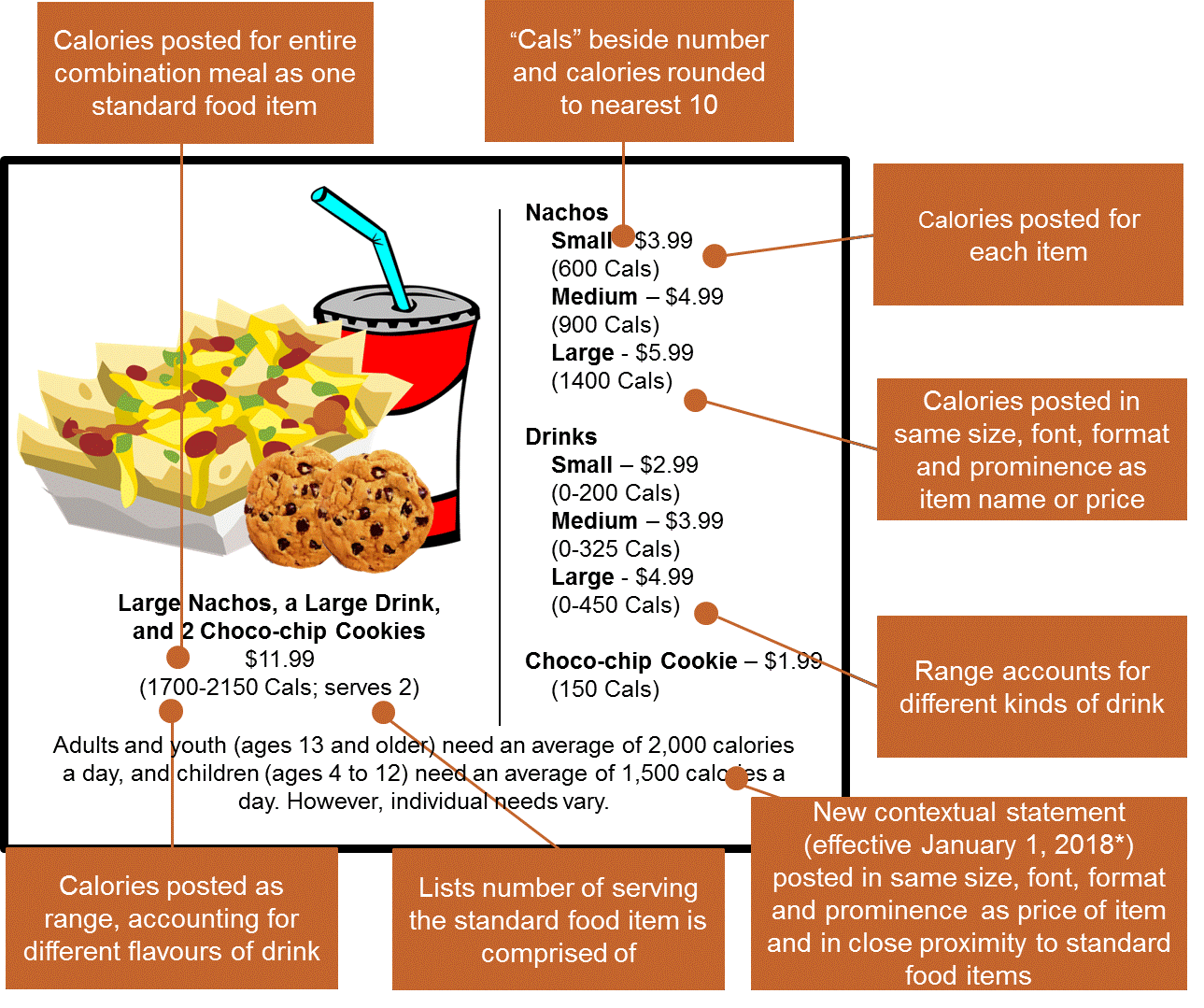
How do you display a range?
Where the number of calories may or must be displayed as a range, the range must be displayed in the following format:
- XX–YY
Where XX is the number of calories of the lowest calorie option and YY is the number of calories of the highest calorie option.
How should calories be displayed for self-serve food and beverages or buffets?
For restaurant-type food or beverage items that customers serve themselves, calories must be displayed on one or more signs, in close proximity to and clearly associated with the item, that states the:
- Number of calories per serving of the food or drink item;
- Serving size used to determine the number of calories; and
- Name of the food or drink item.
The term ‘‘Calories’’, “CALORIES”, ‘‘Cals’’ or “CALS” must appear:
- Adjacent to the number of calories for each standard menu item; or
- As a heading above a column listing the number of calories for each standard menu item.
The term “Calories”, “CALORIES”,“Cals” or “CALS” must be displayed in the same size, font and prominence as the calorie number.
The sign with calorie information must be:
- Visible and legible to any individual who is in a place in the regulated food service premises where he/she can order food or drink or serve it to himself or herself; and
- Positioned in such a way that an individual could reasonably be expected to clearly associate the calories with the food or drink item.
A sign does not have to be posted if the information that is required to be posted on the sign is set out clearly on a label or tag associated with each food or drink item that complies with the requirements above.
Serving sizes for self-serve items must be determined as follows:
- Where the premises provides a serving instrument or utensil that dispenses uniform amounts of food, by the volume of a serving dispensed by the utensil.
- Where cups or other vessels are offered for self-serve drinks, by the volume of the cups or vessels, expressed in milliliters or, if applicable, by description of the cup size.
- For other food or drink items, by a reasonable serving size determined by the person who owns or operates the regulated food service premises.
Example #16 and #17: Displaying calories for self-serve food items
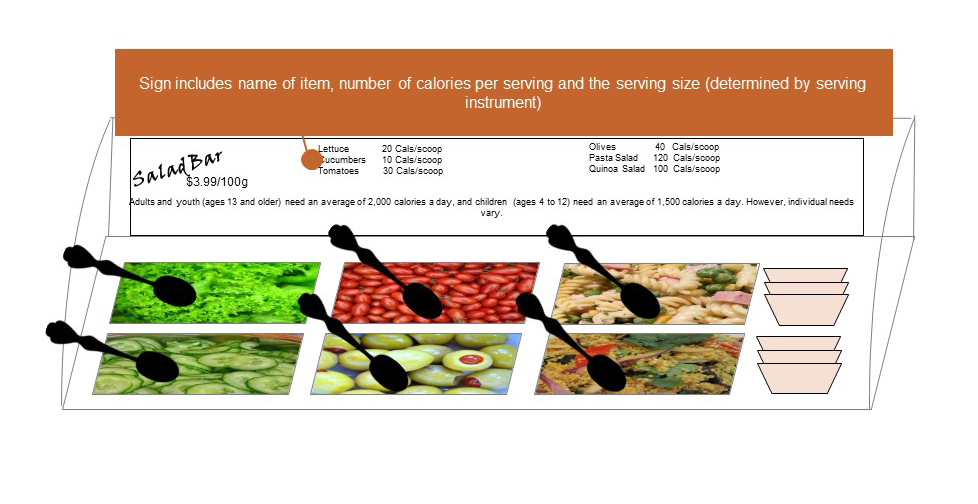
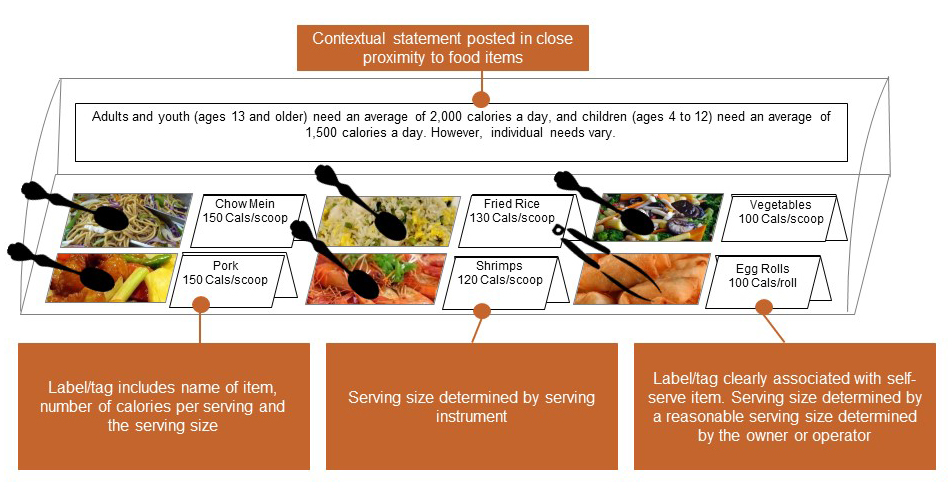
Self-Serve Beverages
For self-serve beverages, calorie ranges for each serving size of every category of beverage can be displayed on a sign in close proximity to the dispenser. The sign must be readily visible and legible.
Example #16: Displaying calories for self-serve beverages
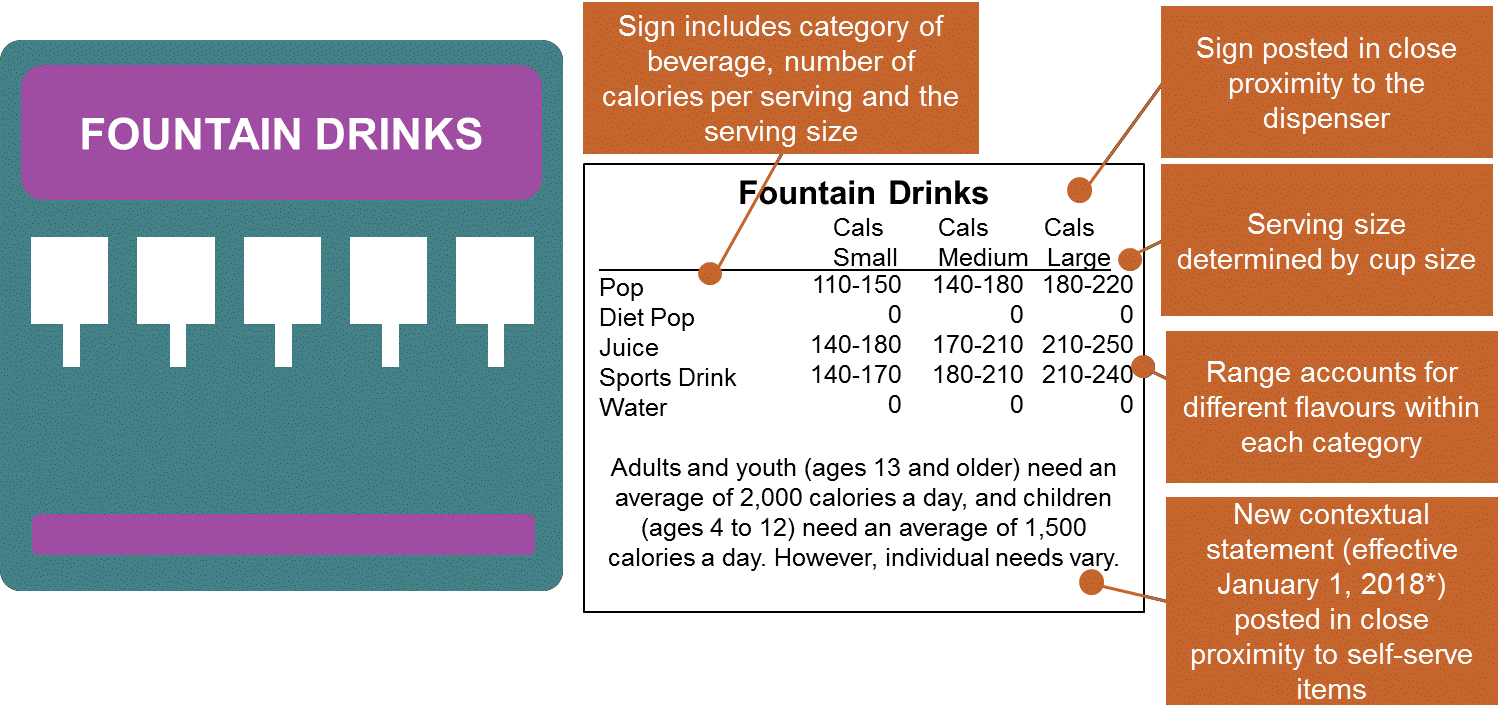
How must calories be displayed for alcohol?
Calories must be displayed for alcoholic beverages listed on a menu, label or tag.
However, a regulated food service premises that sells alcoholic beverages will be exempt from displaying calories for each of their alcoholic beverages if they display the following Table, which lists the calories for common alcoholic beverages:
| Standard Alcoholic Beverages | Standard Serving Size | Approximate Average Calories per Standard Serving Size |
|---|---|---|
| Red Wine (12%) | 1 glass (142 mL/5 oz) | 130 |
| White Wine (12%) | 1 glass (142 mL/5 oz) | 120 |
| Regular Beer (5%) | 1 bottle (341 mL) | 150 |
| Light Beer (4%) | 1 bottle (341 mL) | 100 |
| Spirits (40%) | 1 shot (43 mL/1½ oz) | 100 |
|
Note: Actual calories of alcoholic beverages may vary; the addition of mixes will increase the calories of these beverages. Standard serving sizes are based on one drink as outlined in Canada’s Low-Risk Alcohol Drinking Guidelines. |
||
The Table must be:
- In substantially the same format as the Table above (e.g., same rows and columns);
- Displayed in close proximity to where alcoholic beverages are listed on a menu, label or tag; and
- In the same text size and prominence as the listing of the alcoholic beverage(s).
The Table must be fully visible when the menu is opened to any page that lists an alcoholic beverage. For multi-page alcohol menus, an owner or operator can choose to post the Table on every open page (i.e. every other page) of the menu.
If a regulated food service premises displays calories on a menu, label, or tag for some individual alcoholic beverages, but not all, then the above chart must also be displayed on the menu.
If a regulated food service premises chooses to display calories for their individual alcoholic beverages, then the requirements for how calories should be displayed for standard food items apply.
Example #17: Displaying calories for individual alcoholic beverages
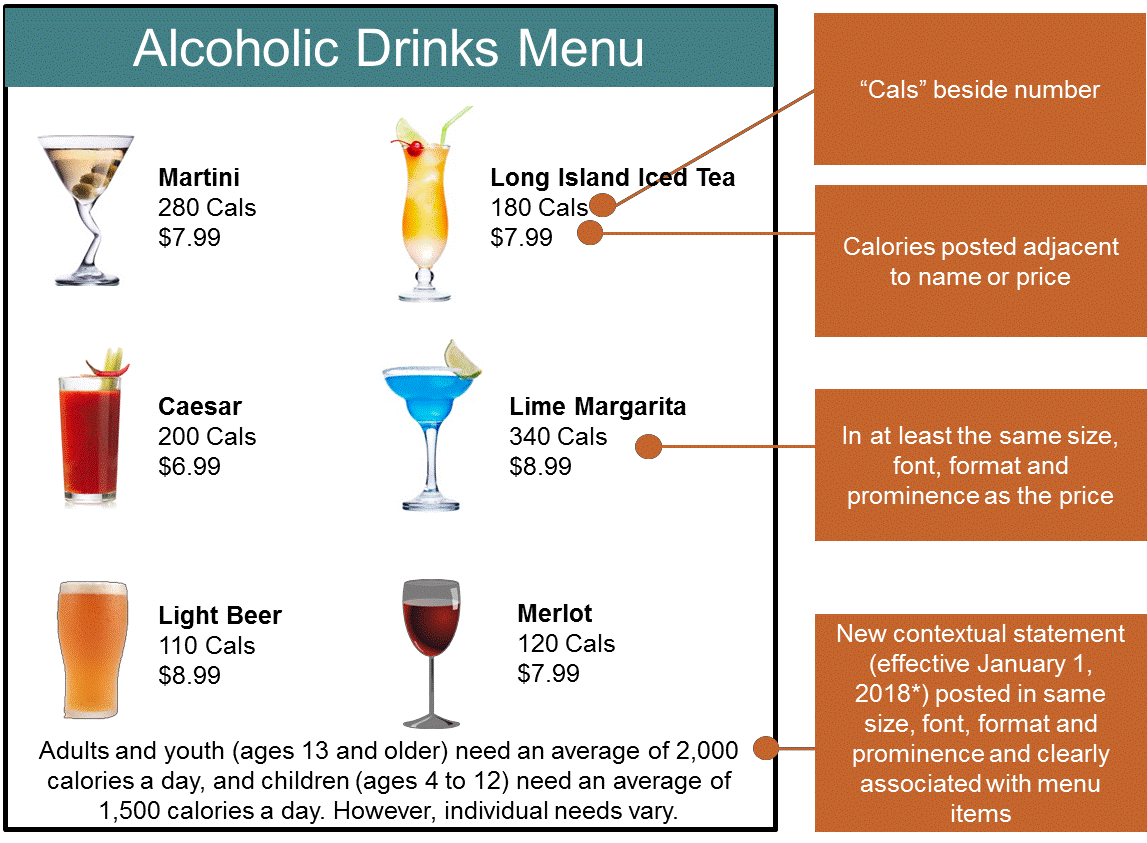
Example #18: Displaying calories for alcoholic beverages using an alcohol table
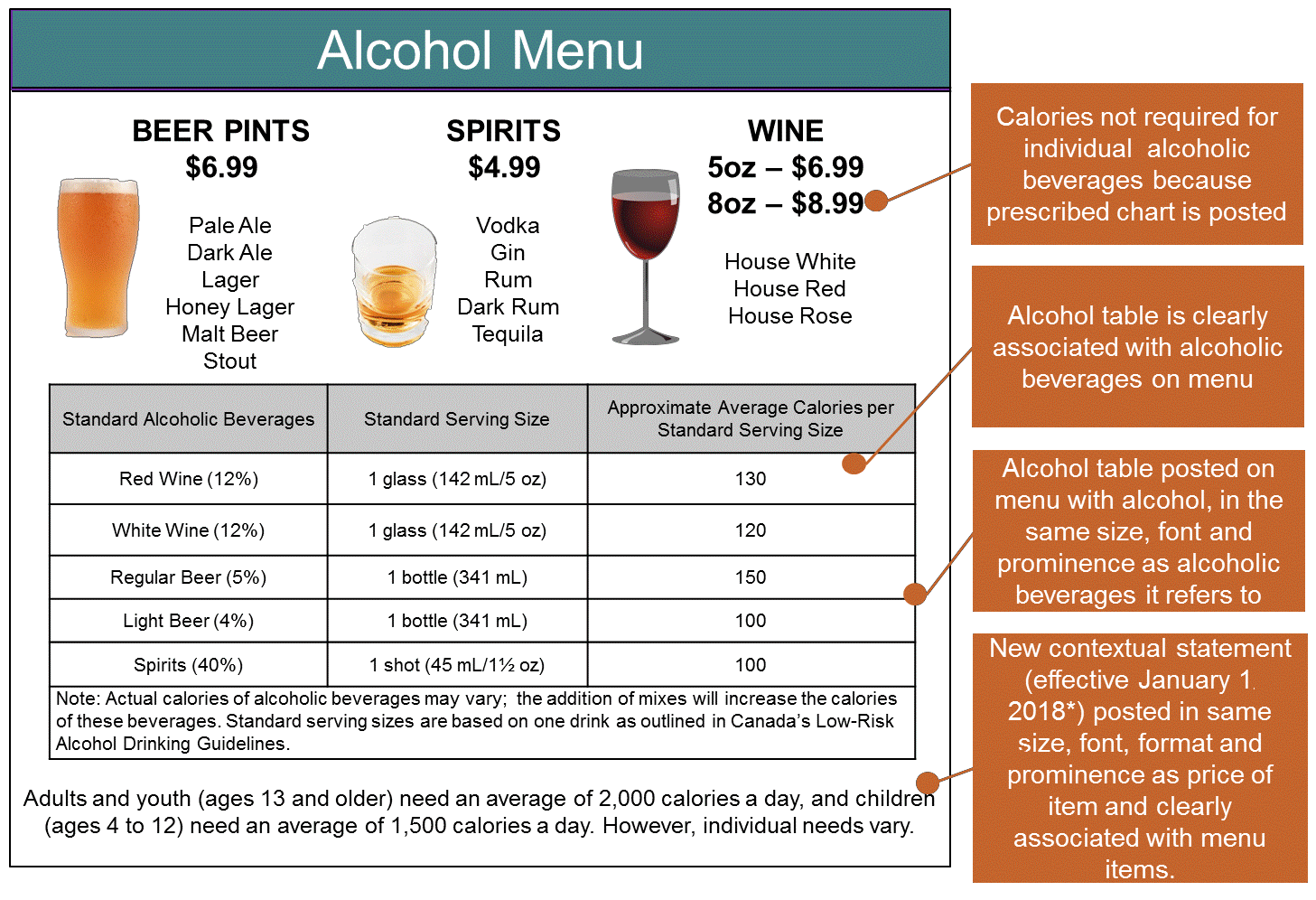
Footnotes
- footnote[1] Back to paragraph Calories only need to be displayed on online menus, applications, advertisements and promotional flyers if the prices for standard food items are displayed and a method to place an order for delivery or take away ordering is provided.